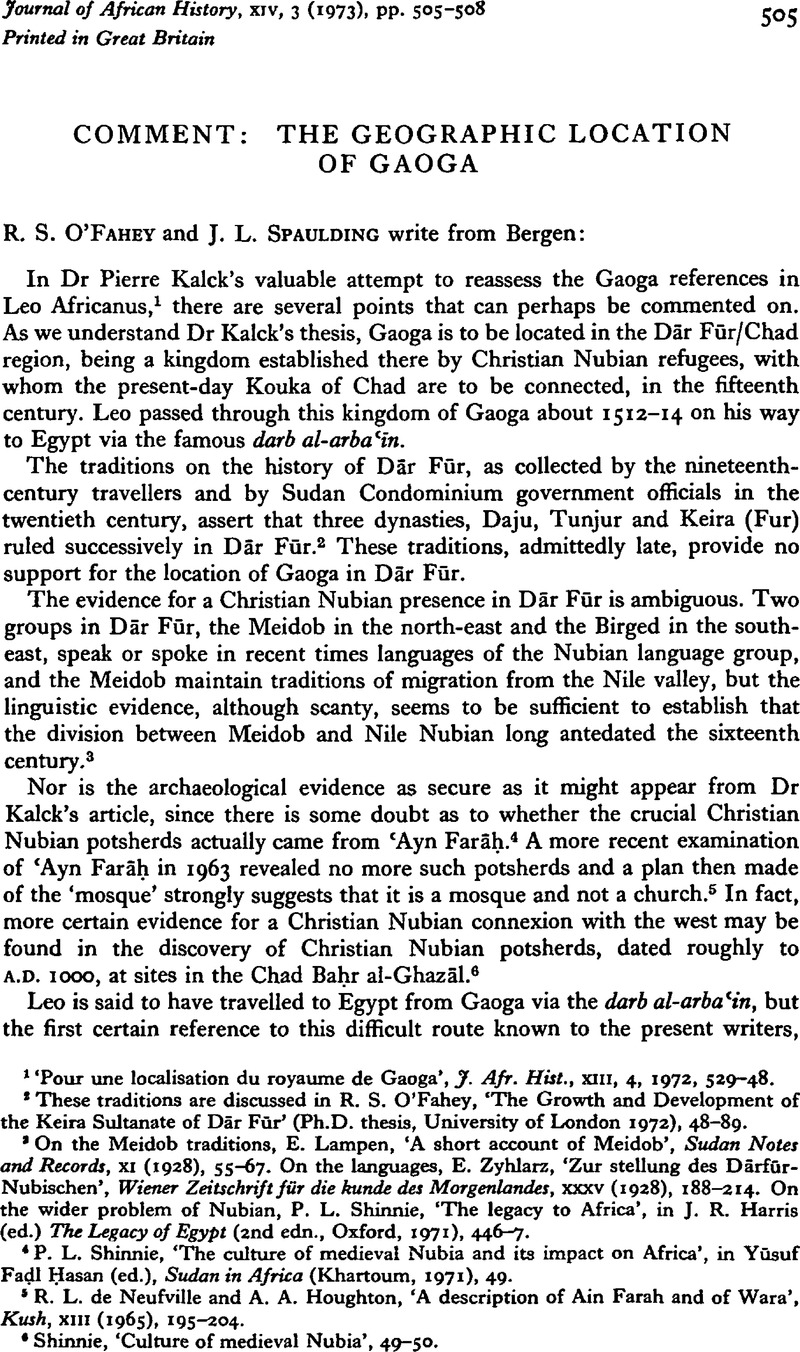Published online by Cambridge University Press: 22 January 2009

1 ‘Pour une localisation du royaume de Gaoga’, J. Afr. Hist., XIII, 4, 1972, 529–48.Google Scholar
2 These traditions are discussed in O'Fahey, R. S., ‘The Growth and Development of the Keira Sultanate of Dār Fūr’ (Ph.D. thesis, University of London 1972), 48–89.Google Scholar
3 On the Meidob traditions, Lampen, E., ‘A short account of Meidob’, Sudan Notes and Records, XI (1928), 55–67.Google Scholar On the languages, Zyhlarz, E., ‘Zur stellung des DārfūrNubischen’, Wiener Zeitschrift für die kunde des Morgenlandes, XXXV (1928), 188–214.Google Scholar On the wider problem of Nubian, Shinnie, P. L., ‘The legacy to Africa’, in Harris, J. R. (ed.) The Legacy of Egypt (2nd edn., Oxford, 1971), 446–7.Google Scholar
4 Shinnie, P. L., ‘The culture of medieval Nubia and its impact on Africa’, in Hasan, Yūsuf Fadl (ed.), Sudan in Africa (Khartoum, 1971), 49.Google Scholar
5 de Neufville, R. L. and Houghton, A. A., ‘A description of Ain Farah and of Wara’, Kush, XIII (1965), 195–204.Google Scholar
6 Shinnie, ‘Culture of medieval Nubia’, 49–50.Google Scholar
7 By Vansleb, J. M. in his account of his first Visit to Egypt in 1663,Google Scholar in Paulus, H. E. G. (ed.), Sammlung der Merkwürdigsten Reisen in den Orient (4 vols., Jena 1792–1798), III, 45–6.Google Scholar
8 Busayli, Al-Shātiral-Jalīl, 'Abd, makhhūha kātib al-shūna fī ta'rīkh al-sulhāna al-sinnāriyya wa'l-idāra al-misriyya (Cairo, 1961), 7;Google ScholarHillelson, S., ‘David Reubeni, An Early Visitor to Sennar’, Sudan Notes and Records, XVI (1935), 55–66.Google Scholar
9 Ahmad, ‘Abd al-Rahīm Nasr, ta'rikh al-'abdallāb, min khilāl ruwāyātihim al-sima'iyya (Khartoum, 1969), 19.Google Scholar
10 Hillelson, ‘David Reubeni’, 59.Google Scholar
11 de Villard, U. Monneret, ‘La prima esplorazione archeologica dell'Alto Egitto’, Bulletin de la Société Royale de Géographie d'Égypte, XVII (1929), 19–48.Google Scholar
12 Giamberardini, G. (ed.), ‘I Viaggiatori Francescani attraverso la Nubia dal 1698 al 1710’, Collectanea No. 8, Studi Orientali Christiani-Ægyptiaca (Cairo, 1963), 383.Google Scholar
1 Macmichael, Harold Alfred, A history of the Arabs in the Sudan and some account of the people who preceded them and of the tribes inhabiting Darfur. (Cambridge, 1922), 2 volumes.Google Scholar
2 Leyder, J., ‘Note préliminaire à l'étude des grandes migrations de l'Afrique Centrale.’ Revue inst. sociol. 13, I, 44, 47.Google ScholarLeyder, J., ‘De l'origine des Bwaka (Ubangi).’ Bulletin SRBG (Bruxelles, 1936), no. I, 49–71.Google ScholarHutereau, , Histoire des peuplades de l'Uellé et de l'Ubangui, (Bruxelles, Goemare 1922), 334.Google ScholarTanghe, Mgr Basile, ’Histoire générale des migrations de peuples de l'Ubangi’, Revue Congo, Bruxelles 1938.Google ScholarTanghe, Mgr Basile, ‘Pages d'histoire africaine: essai de reconstitution des liens de famile patemelle qui retiennent entre elles lea populations soudanaises du nord du Congo’, Aequatoria, 1943, no. VI, 1944, no. VII.Google Scholar